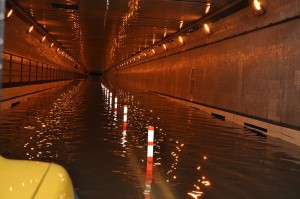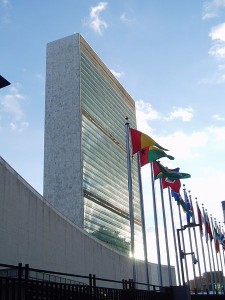September 3, 2014
An Empire State of Mind On Climate Change
Posted by Fushcia Hoover
By Fushcia Hoover
WASHINGTON, DC – On 23 September 2014, the U.N. Secretary-General will host leaders from around the world at the United Nations headquarters in New York City to engage in discussion, and hopefully make commitments, on a legal climate agreement for the year 2015. The leaders will discuss four themes: the science of climate change, societal benefits that come with taking action on climate change, why climate action makes sense for business and economic growth, and voices from the frontlines of climate change.

The Queens Midtown Tunnel flooded during Hurricane Sandy Courtesy of: Mark Valentin, Wikipedia Commons
Besides the fact that the U.N is headquartered in New York City, it’s as good of a place as any to hash out international compromise on climate change. The state is expected to see a 71 percent increase in heavy precipitation according to the 2014 National Climate Assessment (NCA). During the 2020’s alone, New York is projected to see a sea level rise of two to ten inches, with more than 100 percent increases by the 2050’s according to Dr. Radley Horton, associate research scientist at Columbia University and convening lead author on the NCA panel for the Northeast. Given the millions of people reside in the city, and with a projection of one million new residents by 2030, anticipating events like Hurricane Sandy that caused $19 billion in economic losses require serious long-term thinking.. Thankfully, the city has been heavily engaged in risk management and resiliency planning in preparation for these changes, particularly since Sandy.
PlaNYC is a ten-year plan established in 2007 and updated in 2014 that seeks to create a greener and greater New York through four initiatives. The four actions include growth, infrastructure, a global economy, and climate change. The task force that brought this plan together looked at the aftermath of Hurricane Sandy and asked three questions: What happened during Sandy and why, what could happen in the future, and how do we rebuild post-Sandy and prepare for a future with climate change. Consequently, the task force identified information relevant to future infrastructure design and planning for storms.
The city has developed a comprehensive plan that includes over 257 projects like the Clean Heat organization, which seeks to improve air quality and human health by encouraging and providing resources to business, residents, and other organizations to eliminate the use of heavy oils for heating. Or the Cool Roofs Project, a partnership between the NYC Department of Buildings and the NYC Service to promote and facilitate practices for lowering the energy costs, city temperatures, carbon emissions and other urban heat island effects by applying reflective white coatings to rooftops. Many of these initiatives and plans stress the importance of local action. A 2014 progress report on the PlaNYC details the 29 projects already completed and the 202 that are currently underway. Through these types of programs, New York will likely serve as an example of local climate change planning and serve to inspire and generate new ideas and initiatives amongst the countries’ leaders who will be visiting the UN headquarters in September.
Fushcia Hoover is an intern with the Public Affairs Department at AGU.



No one wants to live on a polluted planet but there are so many other problems than climate change. There are so many issues to address so I’ll just pick one that has me questioning the intent of the IPCC and other conferences and committees etc. Why do these events exaggerate and concentrate on negative, destructive consequences of climate change? Are there NO benefits?The increase of CO2 is increasing measurable but there are legitimate questions that need to be answered about it’s effects. For example: Why is the so called temperature “hiatus” so casually dismissed and minimized instead of debated? For example, If temperature is remaining relatively flat despite CO2 increases there must be other component affecting atmospheric temperature. Why not admit this and develop an meaningful explanation other than a “hiatus”?